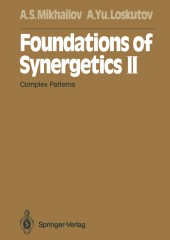 Neuerscheinungen 2012Stand: 2020-01-07 |
Schnellsuche
ISBN/Stichwort/Autor
|
Herderstraße 10
10625 Berlin
Tel.: 030 315 714 16
Fax 030 315 714 14
info@buchspektrum.de |

Alexander Yu. Loskutov, Alexander S. Mikhailov
(Beteiligte)
Foundations of Synergetics II
Complex Patterns
Softcover reprint of the original 1st ed. 1991. 2012. viii, 210 S. VIII, 210 pp. 98 figs. 242 mm
Verlag/Jahr: SPRINGER, BERLIN 2012
ISBN: 3-642-97296-9 (3642972969)
Neue ISBN: 978-3-642-97296-6 (9783642972966)
Preis und Lieferzeit: Bitte klicken
This textbook is based on a lecture course in synergetics given at the University of Moscow. In this second of two volumes, we discuss the emergence and properties of complex chaotic patterns in distributed active systems. Such patterns can be produced autonomously by a system, or can result from selective amplification of fluctuations caused by external weak noise. Although the material in this book is often described by refined mathematical theories, we have tried to avoid a formal mathematical style. Instead of rigorous proofs, the reader will usually be offered only "demonstrations" (the term used by Prof. V. I. Arnold) to encourage intuitive understanding of a problem and to explain why a particular statement seems plausible. We also refrained from detailing concrete applications in physics or in other scientific fields, so that the book can be used by students of different disciplines. While preparing the lecture course and producing this book, we had intensive discussions with and asked the advice of Prof. V. I. Arnold, Prof. S. Grossmann, Prof. H. Haken, Prof. Yu. L. Klimontovich, Prof. R. L. Stratonovich and Prof. Ya.
1. Introduction.- 1.1 Chaotic Dynamics.- 1.2 Noise-Induced Complex Patterns.- 1.3 Chaos and Self-Organization.- 2. Unpredictable Dynamics.- 2.1 Hamiltonian Systems.- 2.2 Destruction of Tori.- 2.3 Ergodicity and Mixing.- 3. Strange Attractors.- 3.1 Dissipative Systems and Their Attractors.- 3.2 The Lorenz Model.- 3.3 Lyapunov Exponents.- 3.4 The Autocorrelation Function.- 4. Fractals.- 4.1 Self-Similar Patterns.- 4.2 Dimensions.- 4.3 Fractal Dimensions of Strange Attractors.- 5. Discrete Maps.- 5.1 Fixed Points and Cycles.- 5.2 Chaotic Maps.- 5.3 Feigenbaum Universality.- 6. Routes to Temporal Chaos.- 6.1 Bifurcations.- 6.2 The Ruelle-Takens Scenario.- 6.3 Period Doubling.- 6.4 Intermittency.- 7. Spatio-Temporal Chaos.- 7.1 Embedding Dimensions.- 7.2 Phase Turbulence.- 7.3 Coupled Chaotic Maps.- 8. Random Processes.- 8.1 Probabilistic Automata.- 8.2 Continuous Random Processes.- 8.3 The Fokker-Planck Equation.- 9. Active Systems with Noise.- 9.1 Generalized Brownian Motion.- 9.2 Internal Noise.- 9.3 Optimal Fluctuations.- 10. Population Explosions.- 10.1 Mean Ignition Time of Explosion.- 10.2 Intermittency of Growth.- 10.3 Breeding Centers.- 11. Extinction and Long-Time Relaxation.- 11.1 Random Traps.- 11.2 Irreversible Annihilation.- 11.3 Conserved Quantities and Long-Time Relaxation.- 11.4 Stochastic Segregation and the Sub-Poissonian Distribution.- 12. Catastrophes.- 12.1 Second-Order Phase Transitions.- 12.2 Sweeping Through the Critical Region.- 12.3 The Biased Transition.- 12.4 Population Settling-Down.- 12.5 Survival in the Fluctuating Environment.- References.
The subject of chaos and, in particular, the complex chaotic patterns that can arise in distributed active systems are topics that are currently attracting much attention from various branches of science. This book and its recently published partner volume offer an excellent introduction to the basic theory of cooperative behavior in distributed active systems and are written at a level that is accessible to undergraduate students.


